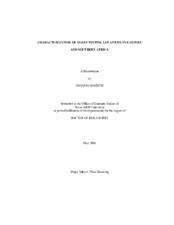| dc.description.abstract | The region of eastern and southern Africa is very diverse in environments and
agronomic practices. The region has one of the highest per capita consumption of maize (Zea
mays. L), which is predominantly produced by smallholder farmers. Some important constraints
facing these farmers include drought and low fertility. For decades, the International Center for
Wheat and Maize Improvement (CIMMYT) has been involved in developing maize genotypes
that have high grain yields and are tolerant to drought, low fertility and other important
constraints. This germplasm is developed for wide adaptation. However, the development of
superior germplasm is significantly affected by interaction between genotypes and the
environment (i.e., genotype by environment interaction, GEI). To estimate and understand GEI
maize genotypes are evaluated in a range of environments representing as much variability of the
target growing areas as possible. Because of dwindling resources needed to conduct testing in
the region, it may not be possible to test in all potential target areas. Therefore, a careful process
of site selection for testing is essential to improve efficiencies in cultivar testing and deployment.
The objective of this research was to characterize the maize testing locations of the
eastern and southern Africa region. Historical data from CIMMYT Regional Trials from 1999 to
2003 was used to characterize the environments and estimate genetic parameters.
Environmnent and GEI showed consistently high contributions to the total variation
observed among genotypes for grain yield. Environment contributed over 60% and sometimes
up to 85% of total variation observed. Sequential retrospective pattern analysis (Seqret) was
conducted on the adjusted standardized grain yield.
A total of 7 groups of environments were identified. Repeatabilites, a measure of the
proportion of phenotypic variation that is due to genetic differences, was reduced under stress
conditions. The relationship among traits showed that anthesis-silking interval (ASI) is an
important selective trait, which can improve selection efficiency for grain yield under stress conditions. Stability analysis provided an opportunity to observe the response and adaptation of
genotypes to a wide range of environments. Variety ZM621 was a stable and high yielding
genotype. | en |


